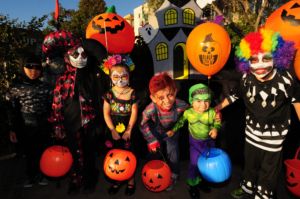Having a Safe and Happy Halloween
For many families across the country, Halloween is the favorite holiday of the season. Many of its traditions are wholly unique and easily resonate with adults and children alike. However, over generations, the day of Halloween has generated its fair share of adverse incidents, and a little bit of care and preparation will go a long way in making sure you and your children can have the safest and most fun Halloween you can.
Safety Tips for Costumes
Halloween costumes are for many people the best part of the occasion. The prospect of being allowed for one day to dress up practically however you want is exciting and fun. However, if trick or treating is planned for later in the evening, you will need to make sure the costume is readily visible in low light situations. Even if all the motorists in the neighborhood are aware that trick or treating is going on, all it takes is a slight distraction to reduce reaction time. When planning for costumes that will go trick or treating later, consider a generally light color scheme. If that isn’t in the cards, then at the very least you may want to utilize reflective tape or stickers to highlight parts of the costume’s profile. These same reflective devices can also be used on the candy bag or pail that will be carried around while trick or treating. To help even further, equipping your trick or treaters with a flashlight or glowsticks will also raise visibility.
Pay attention to the overall fit of the costume, especially if it is homemade. You want to make sure that the costume fits well enough so that tripping or falling over parts of it will not be an issue. Another thing that might help is utilizing face paint and makeup instead of a wearable mask. Masks are a staple Halloween tradition, to be sure, but if poorly designed they can obstruct the vision of whoever is wearing it. Have your children try on any masks involved with their costumes and take a test walk around a controlled space. Even if they’re not tripping over furniture, make sure that they are comfortable navigating the neighborhood streets for a prolonged period.
Operation: Trick or Treat
One of the advantageous tendencies of trick or treating is that it will usually occur in familiar territory, literally your neighborhood. Having said that, attempting to do anything at night or in the dark can create surprisingly awkward or unfamiliar circumstances in otherwise well-known environments. As mentioned before, equipping a trick or treat party with a flashlight can be a prudent measure if the ground at any time will become uneven or if you want to ensure some less lit sections of the street can be safely navigated. Trick or treating as a group is very strongly encouraged. Members can look out for one another and make sure no one gets lost or accidentally injured. Sending a supervising adult for a younger group is highly recommended. Even if older children can easily navigate the neighborhood independently, you want to establish a route for the evening that everyone can agree on. If you head off the possibility of an ill-advised trip to further, perhaps less known neighborhoods, you can more reliably track down where the group may be throughout the night.
When walking through the street, be sure to observe all standard safety tips. Look both ways before crossing, and stick to sidewalks and paths whenever possible. Even though most motorists should be aware Halloween is going on, instruct your children never to assume cars will be looking out for them. As a rule, always attempt to make eye contact or another indication of acknowledgment before crossing in front of a vehicle. If you are leading a group of younger trick or treaters, keep any electronic devices put away so you can focus on the evening’s expedition.
While for some it represents part of the Halloween tradition, pranks involving other people’s property should be discouraged. In the best-case scenario, it creates undue tension for the victim and a mess someone has to clean up later. In more unfortunate circumstances, the perpetrators may encounter any degree of home security or may open themselves up to the risk of injury in the process of committing the deed itself or suddenly trying to escape in the dark. For the safest possible Halloween, pranks are best left alone.
Candy Precautions
A lot of the more prominent tales of Halloween mishap involve candy and treat tampering. Perhaps you’ve heard stories of evil strangers poisoning candy bars or inserting razor blades into apples. While over decades numerous stories like this have emerged, studies show that a significant majority of them are either unfounded or debunked as hoaxes. Despite this, a routine examination of any Halloween candy acquired is generally advisable. Even if vile intentions are not at play, you may still need to inspect for freshness and quality. Most modern sweets are factory produced and come individually wrapped. This is about as sure as Halloween treats get. There are some lesser-known brands with possibly less recognizable or secure packaging. If it does not come in sealed, individually wrapped packaging, unless you highly trust the distributing neighbor, you might want to consider passing giving it to your children. If someone is actually handing out fruit, again, unless you really know the person doing it, you might want to reconsider keeping it. Unless properly stored or packaged, fruit can bruise and quickly pick up contaminants in the environment. A proper washing may allay the fears of some, but approach these cases with caution.
Putting on fancy costumes, decorating the home and porch, and going out to collect trick or treat candy can make for great memories for the entire family. And with a little preparation, a good and safe time can be had by all. The theme of the day may be spooky, but the main objective of the day is to have a Happy Halloween!





